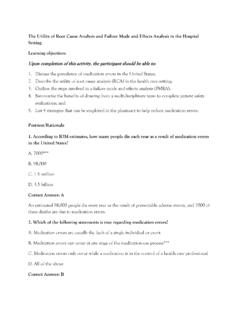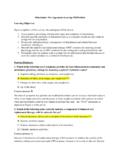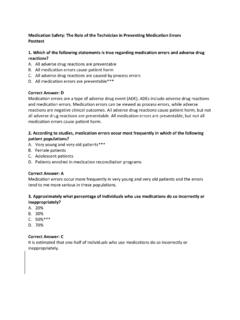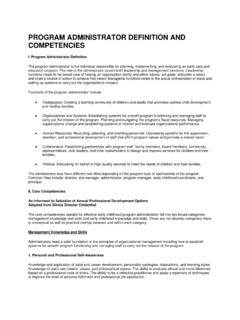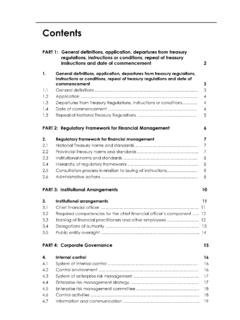Transcription of A Systems Approach to Improving Medication Safety
1 A Systems Approach to Improving Medication Safety EDUCATIONAL OBJECTIVES Upon completion of this activity, participants will be better able to: 1. Use the Institute for Safe Medication Practices' (ISMP) Key Elements of the Medication Use system to identify and prevent risk in daily practice; 2. Describe how to analyze a Medication error using a specific set of steps and associated tools to identify contributing factors and root causes of the event; 3. Specify how to use information gathered during root cause analysis to minimize the reoccurrence of Medication errors; and 4. Select effective error reduction strategies that can prevent patient harm and engage in practices that ensure patient Safety . Post-Test/Rationale 1. Which of the following contributing factors does not fall under the key element of patient education?
2 A. Patient allergy information** B. Nonadherence due to patient health literacy C. No offer to counsel D. Lack of printed materials in patient s native language Correct Answer: A This question requires the reader to differentiate between different contributing factors of the 10 key elements. Choice A follows under Patient Information. Learning objective addressed: Use ISMP s Key Elements of the Medication Use system to help identify and prevent risk in daily practice. 2. Implementing a process in which the cash register, tied to the pharmacy computer system , will lock up and prevent a sale if the prescription has not gone through final verification by a pharmacist is considered to be which type of error reduction strategy? A. Failsafe and forcing functions** B.
3 Simplification C. Automation and computerization D. Standardization Correct Answer: A This question assesses the reader s ability to apply actions as related to error reduction strategies to a situation and to differentiate which are more effective. Option A describes a hard stop, a type of failsafe/constraint. Failsafes and constraints are the highest level risk reduction strategy and would therefore be most likely to reduce the reoccurrence of an error. Learning objectives addressed: Specify how to use information gathered during a root cause analysis to minimize the reoccurrence of Medication errors AND select effective error reduction strategies that can prevent patient harm and engage in practices that assure patient Safety . 3. Which of the following steps is not a part of the RCA process?
4 A. Determine what happened B. Form a team C. Stratify responsible individuals by level of involvement** D. Develop action plan and measures Correct Answer: C This question asks readers to recall the steps involved in the RCA process. It also emphasizes that RCA does not focus on the actions of individuals or place blame. Learning objective addressed: Describe how to analyze a Medication error using a specific set of steps and associated tools to help the user identify the contributing factors and root causes of the event. 4. After identifying the root causes of the event, the team: A. Develops a flow chart B. Communicates the root causes C. Creates an action plan** D. Reports to The Joint Commission Correct Answer: C This question asks readers to recall the steps involved in the RCA process.
5 It also emphasizes that RCA is used to provide a basis for action to improve patient Safety . Learning objective addressed: Describe how to analyze a Medication error using a specific set of steps and associated tools to help the user identify the contributing factors and root causes of the event. 5. Which of the following risk-reduction strategies is not considered high leverage? A. Automation and computerization B. Reminders and checklists** C. Failsafes and constraints D. Forcing functions Correct Answer: B This question requires readers to differentiate among the risk reduction strategies and to be able to determine if they are high-leverage or not. These tend to focus more on Systems and processes. Reminders and checklists still partly rely on human vigilance and memory to be effective.
6 Learning objective addressed: Select effective error reduction strategies that can prevent patient harm and engage in practices that assure patient Safety . 6. The way to prevent errors is to: A. Redesign the Systems and processes that lead to errors** B. Focus on correcting the individuals who make errors C. Discourage practitioners from detecting and reporting errors since the practice of reporting assigns blame D. Alternatives A and B are both correct Correct Answer: A This question requires readers to differentiate among the risk reduction strategies and to be able to determine if they are high-leverage or not. These tend to focus more on Systems and processes. Reminders and checklists still partly rely on human vigilance and memory to be effective. Learning objective addressed: Select effective error reduction strategies that can prevent patient harm and engage in practices that assure patient Safety .
7 7. A successful RCA: A. Provides in-depth understanding of the events in the investigation of the error** B. Only needs to identify to the changes in human error necessary to reduce the risk of a similar event from occurring C. Should only be completed by the person who caused the error D. Should focus on individual performance. Correct Answer: A The reader should be familiar with the characteristics contributing to a successful RCA. RCAs should provide in-depth understanding of the event, identify system and process changes needed to improve, involve the participation of a team, and focus on Systems and processes. 8. Common causes of Medication errors include: A. Failed communication B. Poor drug storage issues C. Drug and drug device related problems D.
8 All of the above** Correct Answer: D This question requires the reader to differentiate between different contributing factors of the 10 key elements. Choice A follows under Patient Information. Learning objective addressed: Utilize ISMP s Key Elements of the Medication Use system to help identify and prevent risk in daily practice. 9. To avoid a correctly filled prescription from going home to the wrong person/house, at the point of sale, the technician should: A. State the address on the receipt and ask the person picking up the prescription to confirm it is the correct address B. State the date of birth on the receipt and ask the person picking up the prescription to confirm it is the correct birth date C. State the phone number on the receipt and ask the person picking up the prescription to confirm it is the correct phone number D.
9 Ask the person picking up the prescription for the date of birth and compare their answer to the date of birth on the receipt** Correct Answer: D This question requires readers to differentiate among the risk reduction strategies and to be able to determine if they are high-leverage or not. These tend to focus more on Systems and processes. Reminders and checklists still partly rely on human vigilance and memory to be effective. Learning objective addressed: Select effective error reduction strategies that can prevent patient harm and engage in practices that assure patient Safety . 10. One way to avoid overdose mix-ups in relation to directions for oral liquids is to: A. Enter data using nonmetric measurements to prevent errors B. Eliminate nonmetric measurements to prevent errors** C.
10 Enter directions using teaspoonfuls only D. Use abbreviations for directions (tsp, tbsp, mL) Correct Answer: B This question requires readers to differentiate among the risk reduction strategies and to be able to determine if they are high-leverage or not. These tend to focus more on Systems and processes. Reminders and checklists still partly rely on human vigilance and memory to be effective. Learning objective addressed: Select effective error reduction strategies that can prevent patient harm and engage in practices that assure patient Safety .
